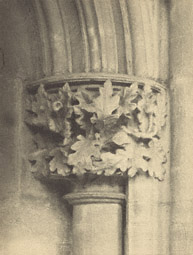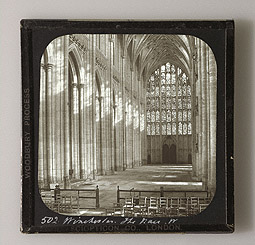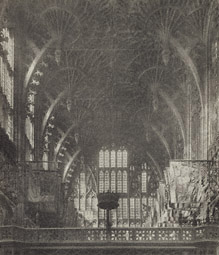 |

 |
 |
"A Sea of Steps"—Wells Cathedral: Stairs to the Chapter House, Frederick H. Evans, 1903
|
 |
 |
|
Frederick H. Evans (British, 1853–1943) was best known for his photographs of medieval cathedrals, such as the image at right of England's Wells Cathedral—arguably the best-known example of his work. Yet Evans was also accomplished in the areas of portraiture, landscape, and photomicrography (photography made using a microscope), and he brought to each subject the same intensity that characterizes his cathedral images. He believed firmly that only a good negative would yield the perfect print, and his high standards for presentation extended to the elaborate mounting of the actual photographs. Using both a "straight" approach (not altering his negatives) and pictorial sensitivity to subject and style, Evans's work, created more than 100 years ago, continues to move and inspire.
In this exhibition, Evans's cathedral subjects are displayed alongside rarely seen landscapes of the English countryside and intimate portraits of the artist's family and friends, including writer George Bernard Shaw and artist Aubrey Beardsley.
|
 |
|
Evans began making landscapes of the English countryside in the early 1880s. Seeking respite from the health problems that he seems to have struggled with all his life, he traveled often to the Lake District in the north of England. The fresh air, stunning landscape, and breathtaking views were a tonic for mind and body. Numerous trips to local woodland areas in Surrey resulted in photographs of majestic trees that recalled the soaring columns of cathedrals. For both his landscapes and portraits, Evans preferred lenses that created images with a "beautiful sense of modelling. There are no sharp lines anywhere and yet no sense of fuzziness."
Evans was a longtime admirer of George Meredith (British, 1828–1909), who was noted for his poems and novels inspired by nature, in particular the woodland areas around his home in Surrey, England. Evans made several trips into the woods, paying homage to the writer. He mounted this photograph on stiff paper, with a simple pencil border, and pasted underneath Meredith's poem "Dirge in the Woods."
|
 |
|
Kelmscott Manor was built in the late 1500s adjacent to the river Thames. Since 1871 the Tudor farmhouse had been the summer home of William Morris, leader of the Arts and Crafts movement, and the Pre-Raphaelite painter Dante Gabriel Rossetti. Kelmscott Manor played a key role in Morris's life; he used it in his novel about a utopian socialist society, News from Nowhere, and even named his private press after it.
In a series of photographs Evans made of Kelmscott in 1896, he approached his subject with a technique similar to that used for his cathedral pictures. He studied the location and considered the architectural space in a series of views that sought to capture the soul of the place—the unspoiled craftsmanship and organic feel that attracted Morris. Together the photographs are a symbolic portrait of William Morris.
Evans's photographs of Kelmscott's sparse loft are arguably some of the most spiritual of his career. Replete with symbolism—from the rough-hewn beams that suggest the Christian cross to the light that emanates from the doorway and beckons the viewer to ascend and cross the threshold from one room (or state of being) to another—the photographs have a mystical aura.
|
 |

 |
 |
Southwell Cathedral: Chapter House Capital, Frederick H. Evans, 1898
|
 |
 |
Through a deep understanding of his subject and a delicate handling of light, mass, and volume Evans created photographs of medieval cathedrals that capture the innate spirituality of these stone edifices. More than simply recording their physical features, Evans sought an emotional connection with the buildings he photographed, urging, "Try for a record of an emotion rather than a piece of topography." Evans's cathedral photographs were popular and reflected the tradition within the graphic and literary arts at the time that celebrated the historical and architectural value of these buildings. Nonetheless, that tradition was of secondary interest to Evans, who stated, "It is the beautiful rather than the antiquarian aspect that attracts me."
Noted for its exquisite botanical carvings, Southwell Cathedral is known as the Cathedral and Parish Church of the Blessed Virgin Mary. With its rounded arches and highly detailed relief carvings, it is an example of both Romanesque and Gothic architecture, and it was built between about 1108 and about 1300 in Nottinghamshire, England. Evans worked in a smaller format for this site, perhaps as a way to focus on the delicate details of the carvings.
|
 |
 |

 |
 |
Winchester Cathedral: The Nave, West, Frederick H. Evans, about 1883
|
 |
Winchester Cathedral, dedicated to the Holy Trinity and Saints Peter, Paul, and Swithun, was begun in 1079 and completed in 1093. Located in Winchester, in southeastern England, the building is noted for its exquisite Gothic nave, which, with its ribbed vaulting is one of the longest in Europe. It was the site of many royal events, including the wedding of Queen Mary I and King Philip of Spain in 1554, and the celebrated novelist Jane Austen is buried there.
This image is a glass lantern slide, made to project an image onto a screen. Evans made thousands of these slides that he used during public lectures about his work. He preferred the glass medium to paper, stating that paper's opacity was unsatisfactory for presenting mass and volume, whereas glass, with its transparency, "suggests the natural depth of the photographic image, which is never a surface image, as in a drawing."
|
 |

 |
 |
Westminster Abbey: Chapel of Henry VII, Roof of Fan Tracery Vaulting, Frederick, H. Evans, 1911
|
 |
 |
|
|
 |
In 1911 Evans was commissioned by Country Life magazine to document the abbey for the upcoming coronation of King George V. He did not record the actual ceremony, which took place June 22, but he was able to photograph the interior in the spring and again in late summer, after the event. In preparation, the abbey was cleared of all furniture, revealing large, open spaces that afforded Evans wonderful views he would have unlikely been able to capture otherwise.
Built in about 1050, the Collegiate Church of Saint Peter at Westminster, in London, held the status of a cathedral briefly, from 1546 to 1556. Since 1579 it has been a Royal Peculiar, meaning that it is under the jurisdiction of the Crown rather than a bishop or diocese. It continues today as the site for coronations and burials of the British monarchs.
All images © Mrs. Janet M. Stenner, sole granddaughter of Frederick H. Evans
|
 |